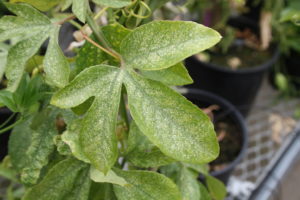Miticides for Use in Greenhouse Production Systems
Answer: It will be my pleasure. A wide range of miticides can be used in greenhouse production systems to mitigate problems with the twospotted spider mite, Tetranychus urticae, which is the most commonly encountered mite pest of greenhouse-grown horticultural crops. A listing of the commercially available miticides is presented in Table 1. However, let’s discuss these miticides in detail. First and foremost, not all the miticides have activity on all the life stages of the twospotted spider mite; some are active on the later life stages (e.g., nymphs and adults) whereas others are active on the early life stages (e.g., eggs and larvae). This information is available in Table 1 below.
Now we will discuss activity type. Eight miticides only have contact activity including: acequinocyl (Shuttle), bifenazate (Floramite), clofentezine (Notavo), cyflumetofen (Sultan), fenazaquin (Magus), fenpyroximate (Akari), hexythiazox (Hexygon) and pyridaben (Sanmite); so thorough coverage of leaf undersides is critical because this is where all the life stages (eggs, larvae, nymphs and adults) are typically located. Seven miticides have translaminar or local systemic activity, such as abamectin (Avid), abamectin + bifenazate (Sirocco), chlorfenapyr (Pylon), etoxazole (TetraSan), spiromesifen (Savate) and spirotetramat (Kontos).

These miticides penetrate leaf tissues and form a reservoir of active ingredient within the leaf. Consequently, this provides residual activity against spider mites after leaf surface residues have dissipated. Spirotetramat (Kontos) is the only miticide with systemic properties. However, due to the low water solubility (29 ppm or mg/L), the miticide must be applied at least four weeks before spider mites are present.
What is important to understand is that although there are 14 different miticides, there are only seven different modes of action (refer to the last column of Table 1). For instance, seven of the miticides are mitochondria electron transport inhibitors (METI) including abamectin + bifenazate (Sirocco), acequinocyl (Shuttle), bifenazate (Floramite), cyflumetofen (Sultan), fenazaquin (Magus), fenpyroximate (Akari) and pyridaben (Sanmite). Two miticides are lipid biosynthesis inhibitors [spiromesifen (Savate) and spirotetramat (Kontos)] and two are growth and embryogenesis inhibitors [clofentezine (Notavo) and hexythiazox (Hexygon)]. Abamectin (Avid), chlorfenapyr (Pylon) and etoxazole (TetraSan) have different modes of action from the other miticides (Table 1).
It is important to know the mode of action of all of these miticides to avoid applying miticides in succession with similar modes of action so as to prevent twospotted spider mite populations from developing resistance. A description of the mode of action and the IRAC (Insecticide Resistance Action Committee) mode of action designation is presented in the last column of Table 1. This information will assist you in developing appropriate rotation programs against twospotted spider mite populations. Remember to use a miticide with the same mode of action within a generation, and then switch to miticide with a different mode of action in the next generation.



 Video Library
Video Library 




















